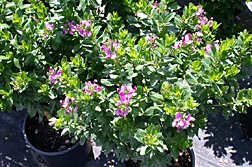Washington, DC
January 6, 2006
ARS News Service
Agricultural Research Service, USDA
Alfredo Flores, (301) 504-1627,
aflores@ars.usda.gov
 A
showy South African evergreen known as cape milkwort could soon
brighten southern U.S. gardens with vibrant masses of year-round
purple blooms. Alan Meerow, a plant geneticist with the
Agricultural Research Service (ARS), is responsible for bringing
the plant to the United States for study. A
showy South African evergreen known as cape milkwort could soon
brighten southern U.S. gardens with vibrant masses of year-round
purple blooms. Alan Meerow, a plant geneticist with the
Agricultural Research Service (ARS), is responsible for bringing
the plant to the United States for study.
When Meerow encountered the cape milkwort (Polygala myrtifolia)
in South Africa in 1997, he soon envisioned it as a welcome
addition to subtropical U.S. gardens. Its flowers form in small
clusters of inch-long blossoms at the ends of short branches.
Lower buds open first, to reveal showy purple petals beautifully
marked with darker veins.
The plant flowers throughout the year, peaking in spring and
summer with profuse blooms amidst bright-green, slightly glossy,
oval leaves roughly two inches long by one-half inch wide. While
the species can grow up to 12 feet high, this particular cape
milkwort--called Chapman Field--only reaches four feet.
Meerow works at the ARS Subtropical Horticulture Research
Station (SHRS) in Miami, Fla. The station's mission is the
conservation and genetic characterization of valuable germplasm.
Seed of P. myrtifolia was purchased from a commercial seed
company in South Africa that is licensed to collect native
plants. After two years of trial and evaluation, the SHRS
researchers selected one seedling with superior attributes. They
named this particular variety Chapman Field in acknowledgment of
work done over the years at SHRS, which is located on what used
to be the U.S. Navy’s Chapman Airfield.
 The
seed population from which Chapman Field was selected originated
in a climate very similar to south Florida’s, and the new
variety stands apart because of its dense foliage, heavy
flowering and quick growth--just two to three months to
propagate. The
seed population from which Chapman Field was selected originated
in a climate very similar to south Florida’s, and the new
variety stands apart because of its dense foliage, heavy
flowering and quick growth--just two to three months to
propagate.
Meerow worked closely with ARS horticulturalist Tomas
Ayala-Silva to add P. myrtifolia to the National Plant Germplasm
System collection and develop this promising evergreen
ornamental for distribution to commercial growers.
Read more about the research in the January 2006 issue of
Agricultural Research magazine, available online at:
http://www.ars.usda.gov/is/AR/archive/jan06/garden0106.htm
ARS is the U.S. Department of Agriculture's chief scientific
research agency.
Una nueva planta tropical de hoja perenne para los jardineros
estadounidenses
Servicio Noticiero del Servicio de Investigación Agrícola (ARS
siglas en inglés)
Departamento de Agricultura (USDA siglas en inglés)
Alfredo Flores, (301) 504-1627,
aflores@ars.usda.gov
Una planta de hoja perenne de Sudáfrica conocida como lechera
del cabo ('cape milkwort' en inglés) pronto podría avivar los
jardines de la región sureña de EE.UU. con masas vibrantes de
flores púrpuras por todo el año. Alan Meerow, un genetista de
plantas con el Servicio de Investigación Agrícola (ARS), es
responsable de traer la planta a EE.UU. para estudios.
Cuando Meerow encontró la planta Polygala myrtifolia en
Sudáfrica en 1997, él pronto la imaginó como una adición
bienvenida a los jardines subtropicales de EE.UU. Sus flores
forman en macizos pequeños de pétalos de una pulgada de largo en
los cabos de las ramas cortas. Los brotes más abajo se abren
primero, para revelar vistosos pétalos púrpuras hermosamente
marcados con venas más oscuras.
Las plantas florecen por todo el año, alcanzando su punto máximo
en la primavera y el verano con flores profusas entre hojas
ovaladas del color verde vivo y un poco brillante que son
aproximadamente dos pulgadas de largo y una pulgada y media de
ancho. Mientras las especies pueden crecer hasta 12 pies en
altura, esta especie particular—llamada 'Chapman
Field'—solamente alcanza cuatro pies.
Meerow trabaja en la Estación de Investigación de Horticultura
Subtropical (SHRS por sus siglas en inglés) mantenida por ARS en
Miami, la Florida. El objetivo de la estación es la conservación
y caracterización de germen plasma valioso.
Semillas de P. myrtifolia fueron adquiridas de una compañía
comercial de semillas en Sudáfrica que es licenciada para
colectar plantas nativas. Después de dos años de ensayos y
evaluaciones, los investigadores del SHRS escogieron un pimpollo
con rasgos superiores. Ellos nombraron esta variedad particular
'Chapman Field' en reconocimiento del trabajo realizado durante
muchos años en SHRS, la cual está ubicada en lo que era el Campo
Chapman de Aviación de la Armada de EE.UU.
La población de semilla de donde Chapman Field fue seleccionada
originó en un clima muy similar a lo de la Florida sureña, y la
variedad nueva es diferente por su follaje denso, flores pesadas
y crecimiento rápido--solamente dos a tres meses para propagar.
Meerow trabajó junto con el horticultor Tomas Ayala-Silva del
ARS para agregar P. myrtifolia a la colección del Sistema
Nacional de Germen Plasma de Plantas y para desarrollar esta
planta ornamental prometedora de hoja perenne para distribución
a los cultivadores comerciales.
Lea más sobre la investigación en la revista 'Agricultural
Research' de enero 2006:
http://www.ars.usda.gov/is/AR/archive/jan06/garden0106.htm
ARS es la agencia principal de investigaciones científicas
del Departamento de Agricultura de EE.UU. |